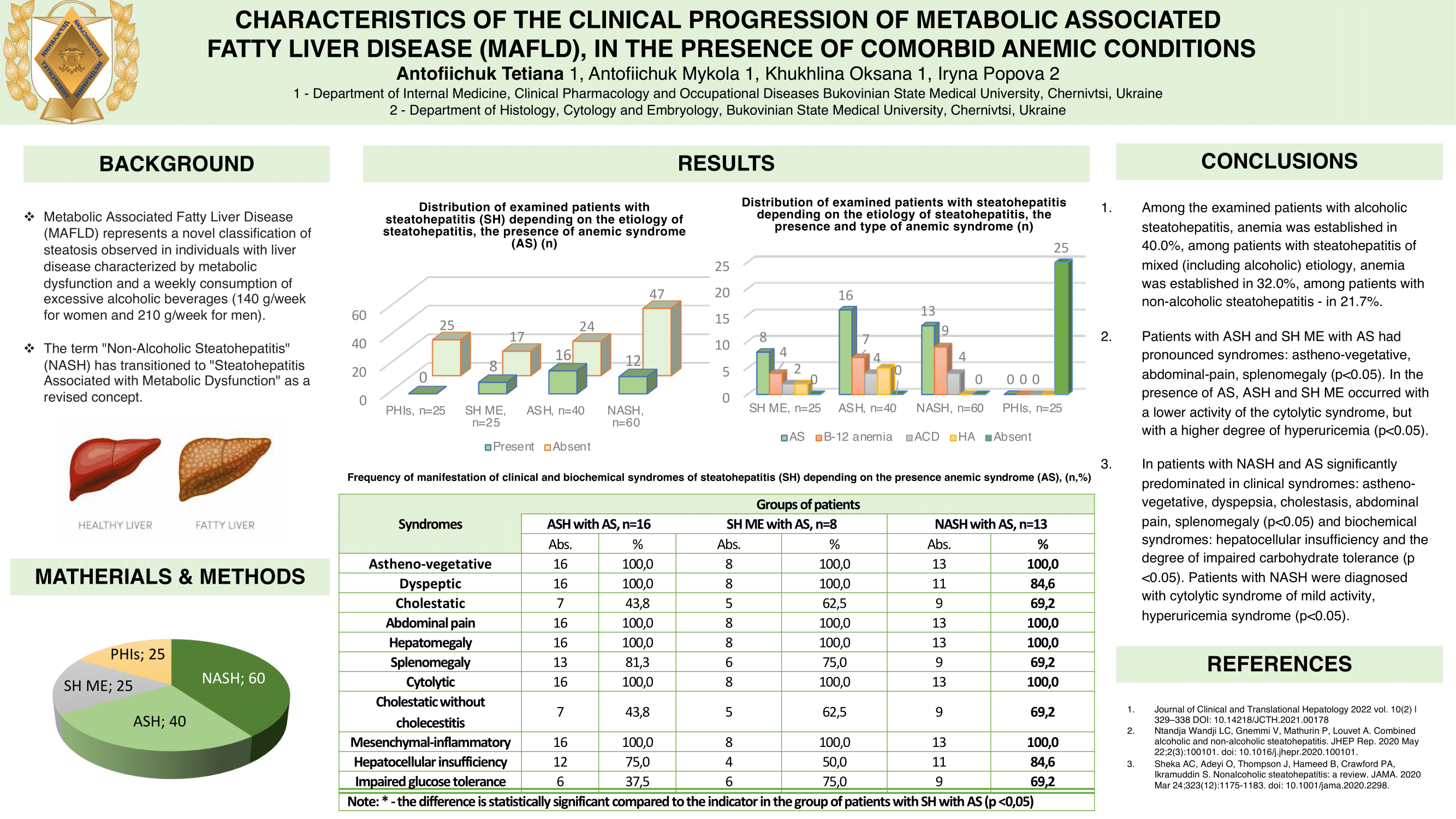Tetiana Antofiichuk
Conference 2024 Poster
Poster Title
Characteristics of the clinical progression of metabolic associated fatty liver disease (MAFLD), in the presence of comorbid anemic conditions.
Authors and Affiliations
Antofiichuk Tetiana 1, Antofiichuk Mykola 1, Khukhlina Oksana 1, Iryna Popova 2
1 – Department of Internal Medicine, Clinical Pharmacology and Occupational Diseases Bukovinian State Medical University, Chernivtsi, Ukraine
2 – Department of Histology, Cytology and Embryology, Bukovinian State Medical University, Chernivtsi, Ukraine
Abstract
Background
Metabolic Associated Fatty Liver Disease (MAFLD) represents a novel classification of steatosis observed in individuals with liver disease characterized by metabolic dysfunction and a weekly consumption of excessive alcoholic beverages (140 g/week for women and 210 g/week for men). Cryptogenic steatohepatitis is diagnosed in cases where the etiology is unknown or lacks metabolic risk factors. The term “Non-Alcoholic Steatohepatitis” (NASH) has transitioned to “Steatohepatitis Associated with Metabolic Dysfunction” as a revised concept.
Methods
A total of 125 individuals diagnosed with steatohepatitis were included in the study, comprising 60 cases of non-alcoholic steatohepatitis (NASH) associated with first and second-degree obesity. Additionally, 65 patients with steatohepatitis of alcoholic and mixed etiology were examined (including 25 with mixed etiology, which involved alcohol). The control group consisted of 40 individuals with alcoholic steatohepatitis (ASH), and 25 practically healthy individuals (PHIs) of similar age and sex. The research took place in the gastroenterological, therapeutic No. 1 and No. 2, and hematological departments of Chernivtsi CCNP “Chernivtsi Emergency Hospital” between 2015 and 2020.
Results
In patients with anemic syndrome (AS) and non-alcoholic steatohepatitis (NASH), clinical syndromes were observed with varying frequencies: astheno-vegetative (36.2%), dyspeptic (27.7%), cholestatic (23.3%), abdominal pain (17.0%), hepatomegaly (100.0%), splenomegaly (23.4%), and endocrine disorders. Meanwhile, under conditions of AS in patients with NASH, the occurrence rates of these syndromes were as follows: astheno-vegetative syndrome (100.0%) was 2.76 times more frequent than in NASH without AS (p<0.05), dyspepsia occurred 3.1 times more often (84.6%), cholestatic syndrome (69.2%) was 3.25 times more common, while the frequency of hepatomegaly (100.0%) did not show statistically significant differences between the comparison groups (p>0.05). However, the occurrence rates of abdominal pain syndrome (100.0%) and splenomegaly (69.2%) were still significantly higher under the condition of comorbidity with AS (p<0.05).
Conclusions
The clinical manifestation of metabolic etiology in conjunction with anemic conditions is distinguished by a heightened occurrence and intensity of both clinical and biochemical syndromes.


Leave A Comment